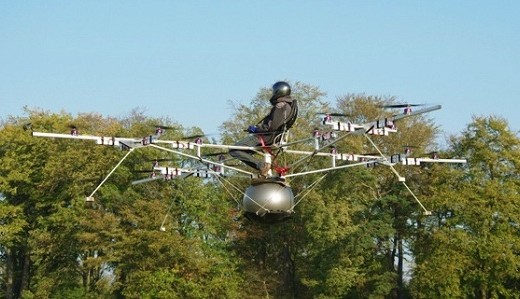World’s first manned flight with an electric multicopter

Last month Thomas Senkel of e-volo completed a series of unmanned tests and was ready for the first manned flight on an airstrip in the southwest of
The e-volo multicopter is an innovative, vertically starting, human carrying transportation device that’s not easily compared to any of its currently flying counterparts. The e-volo’s sixteen propellers allow it to take off and land similar to a helicopter. It’s massive plus points compared to a helicopter are the simplicity of its engineered construction without complicated mechanics and its redundant engines. Should anything go wrong, e-volo can still safely land even if up to four of its sixteen motors should fail. Flight time can last between ten to thirty minutes, depending on the payload and the capacity of the lithium batteries. With an empty weight of 80 kgs (including batteries), e-volo fits into the class of ultralights.
As opposed to other helicopters or multi-rotors, e-volo can use a safety parachute, as there are no propellers blocking the deployment area above.
The propellers create the full lift, and are also responsible for balancing the device on all three axes only by independent speed control of the motors. From the beginning E-volo was designed entirely as an electrically powered device. Unlike the rotor of a helicopter, the propellers do not have any pitch control and therefore no wear. These factors make the multicopter mechanically simple, with almost no maintenance necessary.
The automatic attitude and directional control are taken care of by multiple separate and mutually monitoring onboard computers, controlling the engines with the precise rotation speed necessary to fly this tri-axis device. A simple joystick allows the pilot to control the aircraft via a fly-by-wire system. Whether during vertical takeoff, in flight, or landing, the pilot has to pay little attention to minimum speed, stall, gas mixture control, pitch control or one of many other things that make conventional flight as challenging as it is.
This electrically driven system is quiet, clean and economically cost efficient. A one-hour flight would cost around 6 euros for electricity. In addition, the device holds few parts that could wear out, making maintenance intervals and cost low and far between.
The control firmware can be integrated with a sophisticated integrated GPS system or obstacle detection. As such, automated flight for predetermined points on a 3D map is possible. In addition to the relieving the pilot of strenuous navigational tasks, unmanned flight would be feasible similar to other devices (drones).
The main purpose for a single seat device would most likely be for air sports equipment and in the leisure sector. A professional application could be made in areas where helicopters are too big and expensive, for aerial photographs or field inspection of large facilities (wind turbines, pipelines), areas where its flight capabilities (vertical take off, landing, and hovering) are of crucial importance. As a multi-seater it would also be conceivable to use for sightseeing flights, air ambulance, or air taxi. There most certainly will be entirely new use areas that no one has yet imagined.
